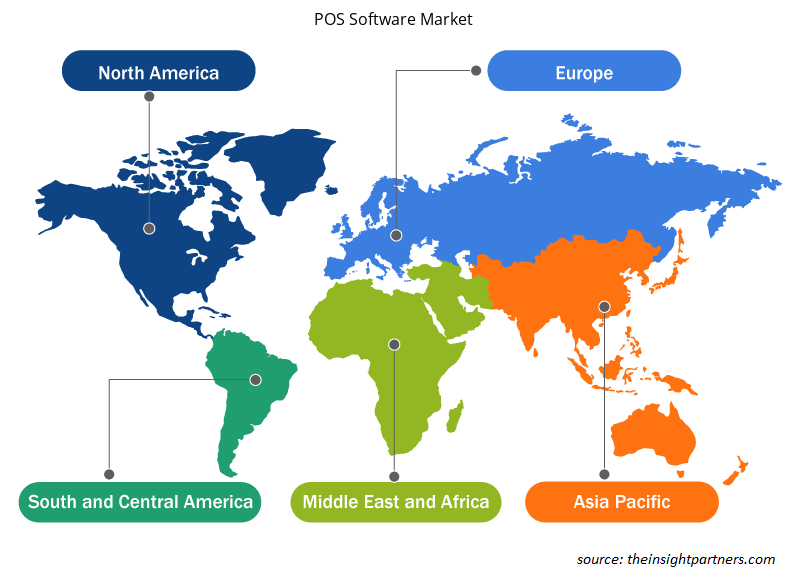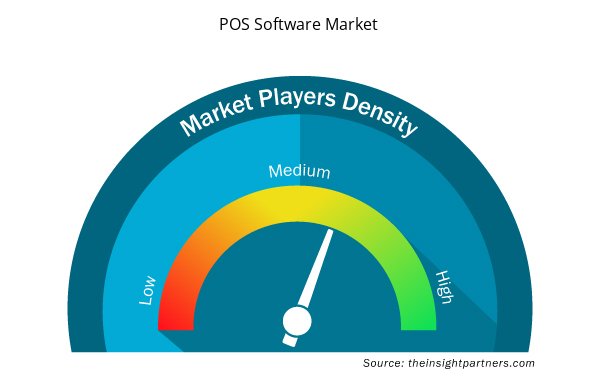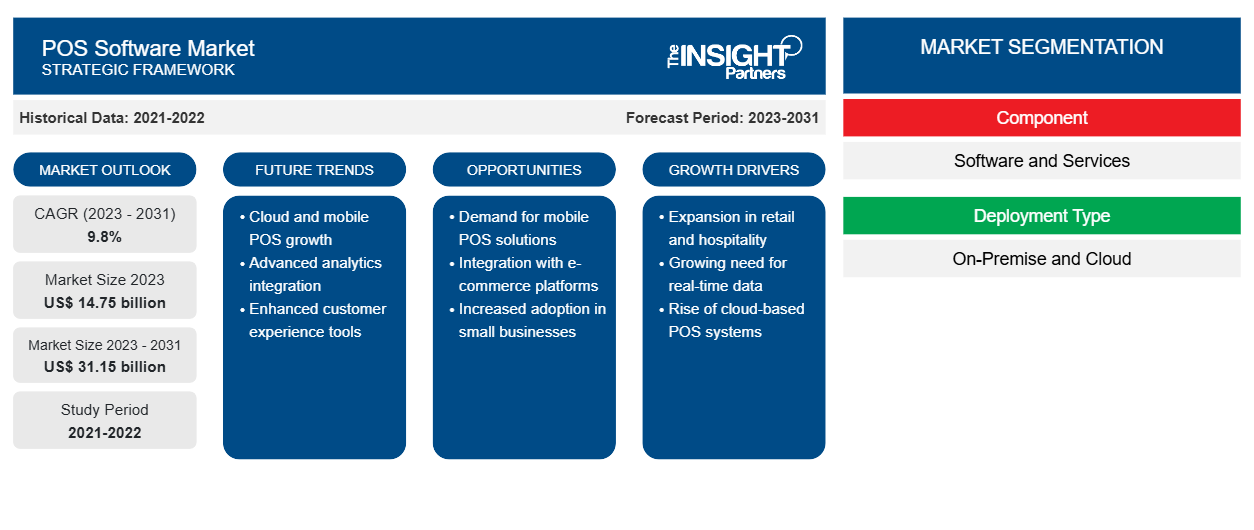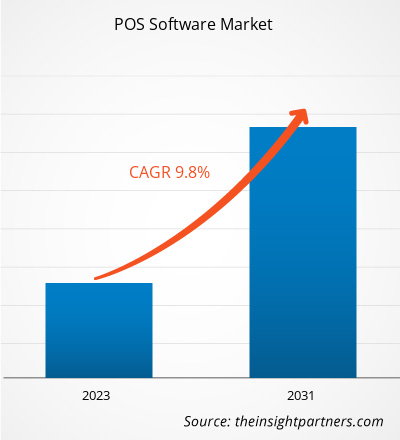Si prevede che la dimensione del mercato del software POS raggiungerà i 31,15 miliardi di dollari entro il 2031, rispetto ai 14,75 miliardi di dollari del 2023. Si prevede che il mercato registrerà un CAGR del 9,8% dal 2023 al 2031. È probabile che l'uso crescente dei servizi di cloud computing rimanga una tendenza chiave del mercato del software POS.
Analisi di mercato del software POS
La necessità di condurre transazioni senza contanti, tracciare i dati di vendita e inventario e sfruttare l'analisi per ottimizzare la strategia di vendita in catene di vendita al dettaglio, ristoranti, hotel, farmacie, officine e altri luoghi ha spinto la domanda di software per punti vendita (POS). Si prevede che l'utilizzo di software POS aumenterà in una varietà di settori a causa della crescente domanda di funzionalità avanzate tra cui gestione dei dati dei clienti, tracciamento dell'inventario, monitoraggio delle vendite, analisi della gestione dei dipendenti e reporting. Inoltre, la crescente domanda di software per punti vendita mobili basati su cloud potrebbe essere attribuita alla crescente accettazione di soluzioni basate su cloud.
Panoramica del mercato del software POS
Il software per punti vendita (POS) è un'applicazione specializzata che le aziende utilizzano per condurre transazioni presso il punto vendita, in genere in contesti di vendita al dettaglio. Tenendo traccia delle vendite, controllando l'inventario e gestendo i pagamenti, velocizza il processo di pagamento. Per garantire l'accuratezza, il software per punti vendita si interfaccia frequentemente con hardware quali scanner per codici a barre , registratori di cassa e lettori di carte. Inoltre, dispone di strumenti per gestire le informazioni dei clienti, creare report di vendita e valutare.
Personalizza questo report in base alle tue esigenze
Riceverai la personalizzazione gratuita di qualsiasi report, comprese parti di questo report, o analisi a livello nazionale, pacchetto dati Excel, oltre a usufruire di grandi offerte e sconti per start-up e università
- Scopri le principali tendenze di mercato in questo rapporto.Questo campione GRATUITO includerà analisi di dati che spaziano dalle tendenze di mercato alle stime e alle previsioni.
Driver e opportunità del mercato del software POS
Crescita del settore dell'e-commerce
Con la crescente prevalenza dello shopping online e omnicanale, le aziende necessitano di software per punti vendita (POS) in grado di collegare senza soluzione di continuità i loro canali di vendita offline e online. Ciò determina la domanda di sistemi per punti vendita (POS) che includano funzioni come il controllo dell'inventario, l'evasione degli ordini e la gestione delle relazioni con i clienti (CRM), che sta alimentando la crescita del mercato dei software per POS.
Crescente domanda di Business Intelligence e Data Analytics
Il software Point-of-sale (POS) sta diventando uno strumento sempre più popolare utilizzato dalle aziende per raccogliere ed esaminare dati su vendite, comportamento dei clienti, inventario e performance dei dipendenti. Tecnologie di analisi e reporting sofisticate possono aiutare le aziende a prendere decisioni basate sui dati, aumentare la soddisfazione dei clienti e ridurre le procedure. Pertanto, si prevede che tali vantaggi del software POS stimoleranno la crescita del mercato nel periodo previsto.
Analisi della segmentazione del rapporto di mercato del software POS
I segmenti chiave che hanno contribuito alla derivazione dell'analisi di mercato del software POS sono i componenti (software e servizi); il tipo di distribuzione (on-premise e cloud); l'applicazione e l'utente finale
- In base ai componenti, il mercato del software POS è diviso in software e servizi. Il segmento software ha detenuto una quota di mercato maggiore nel 2023.
- In base al tipo di distribuzione, il mercato è diviso in on-premise e cloud. Il segmento on-premise ha detenuto una quota di mercato maggiore nel 2023.
- In base all'applicazione, il mercato è segmentato in monitoraggio dell'inventario, gestione degli acquisti, reporting delle vendite, coinvolgimento dei clienti e altri. Il segmento del monitoraggio dell'inventario ha detenuto una quota di mercato maggiore nel 2023.
- In base all'utente finale, il mercato è segmentato in vendita al dettaglio, ospitalità, media e intrattenimento, assistenza sanitaria e altri. Il segmento della vendita al dettaglio ha detenuto la quota maggiore del mercato nel 2023.
Analisi della quota di mercato del software POS per area geografica
L'ambito geografico del rapporto sul mercato del software POS è principalmente suddiviso in cinque regioni:Nord America, Asia Pacifico, Europa, Medio Oriente e Africa e Sud America/Sud e Centro America.
In termini di fatturato, il Nord America ha rappresentato la quota di mercato più grande del software POS. Il mercato in questa regione è segmentato in Stati Uniti, Canada e Messico. La regione ha un certo numero di noti produttori di software POS, così come un'elevata domanda di software POS integrato complesso. Inoltre, il settore della vendita al dettaglio sta assistendo a una crescita enorme nella regione, alimentando la crescita del mercato. Inoltre, si prevede che il settore sanitario statunitense crescerà al ritmo più rapido a causa della necessità di aggiornare le strutture ospedaliere relative ad assicurazione, pagamento e gestione dei pazienti.
Notizie di mercato e sviluppi recenti del software POS
Il mercato del software POS viene valutato raccogliendo dati qualitativi e quantitativi dopo la ricerca primaria e secondaria, che include importanti pubblicazioni aziendali, dati associativi e database. Di seguito è riportato un elenco degli sviluppi nel mercato dei disturbi del linguaggio e della parola e delle strategie:
- US Bank, leader del settore nei servizi di pagamento, ha annunciato il lancio di Avvance, una soluzione di prestito integrata e multicanale per punti vendita. Avvance offre alle aziende la possibilità di offrire finanziamenti ai consumatori durante il pagamento con una rapida richiesta e una decisione immediata. (Fonte: Elavon Inc., Comunicato stampa, 2023)
- NCR Corporation ha presentato NCR Aloha Cloud, una soluzione point of sale (POS) basata su cloud che offre funzionalità sufficientemente solide da essere immesse sul mercato con il marchio leader del settore Aloha. Aloha Cloud offre un'interfaccia utente (UI) rinnovata, il dispositivo portatile più piccolo sul mercato e un'elaborazione dei pagamenti senza interruzioni con finanziamento dei depositi il giorno successivo, dando agli operatori più tempo per concentrarsi sulla gestione del loro ristorante. (Comunicato stampa, 2022)
Approfondimenti regionali sul mercato del software POS
Le tendenze regionali e i fattori che influenzano il mercato del software POS durante il periodo di previsione sono stati ampiamente spiegati dagli analisti di Insight Partners. Questa sezione discute anche i segmenti del mercato del software POS e la geografia in Nord America, Europa, Asia Pacifico, Medio Oriente e Africa e America meridionale e centrale.

- Ottieni i dati specifici regionali per il mercato del software POS
Ambito del rapporto di mercato del software POS
| Attributo del report | Dettagli |
|---|---|
| Dimensioni del mercato nel 2023 | 14,75 miliardi di dollari USA |
| Dimensioni del mercato entro il 2031 | 31,15 miliardi di dollari USA |
| CAGR globale (2023-2031) | 9,8% |
| Dati storici | 2021-2022 |
| Periodo di previsione | 2023-2031 |
| Segmenti coperti | Per componente
|
| Regioni e Paesi coperti | America del Nord
|
| Leader di mercato e profili aziendali chiave |
|
Densità dei player del mercato del software POS: comprendere il suo impatto sulle dinamiche aziendali
Il mercato del software POS sta crescendo rapidamente, spinto dalla crescente domanda degli utenti finali dovuta a fattori quali l'evoluzione delle preferenze dei consumatori, i progressi tecnologici e una maggiore consapevolezza dei vantaggi del prodotto. Con l'aumento della domanda, le aziende stanno ampliando le loro offerte, innovando per soddisfare le esigenze dei consumatori e capitalizzando sulle tendenze emergenti, il che alimenta ulteriormente la crescita del mercato.
La densità degli operatori di mercato si riferisce alla distribuzione di aziende o società che operano in un particolare mercato o settore. Indica quanti concorrenti (operatori di mercato) sono presenti in un dato spazio di mercato in relazione alle sue dimensioni o al valore di mercato totale.
Le principali aziende che operano nel mercato del software POS sono:
- Infor Inc
- Intuit, Inc.
- Velocità della luce
- Società Oracle
- Rete di trifoglio, LLC
- Società NCR
Disclaimer : le aziende elencate sopra non sono classificate secondo un ordine particolare.

- Ottieni una panoramica dei principali attori del mercato dei software POS
Copertura e risultati del rapporto sul mercato del software POS
Il rapporto “POS Software Market Size and Forecast (2023–2031)” fornisce un’analisi dettagliata del mercato che copre le seguenti aree:
- Dimensioni del mercato e previsioni a livello globale, regionale e nazionale per tutti i segmenti di mercato chiave coperti dall'ambito
- Dinamiche di mercato come fattori trainanti, vincoli e opportunità chiave
- Principali tendenze future
- Analisi dettagliata delle cinque forze PEST/Porter e SWOT
- Analisi di mercato globale e regionale che copre le principali tendenze di mercato, i principali attori, le normative e gli sviluppi recenti del mercato
- Analisi del panorama industriale e della concorrenza che copre la concentrazione del mercato, l'analisi della mappa di calore, i principali attori e gli sviluppi recenti
- Profili aziendali dettagliati
- Analisi storica (2 anni), anno base, previsione (7 anni) con CAGR
- Analisi PEST e SWOT
- Valore/volume delle dimensioni del mercato - Globale, regionale, nazionale
- Industria e panorama competitivo
- Set di dati Excel


- Clinical Trial Supplies Market
- Employment Screening Services Market
- Workwear Market
- Enzymatic DNA Synthesis Market
- Fill Finish Manufacturing Market
- Photo Printing Market
- Integrated Platform Management System Market
- Aquaculture Market
- Surety Market
- Quantitative Structure-Activity Relationship (QSAR) Market

Report Coverage
Revenue forecast, Company Analysis, Industry landscape, Growth factors, and Trends

Segment Covered
This text is related
to segments covered.

Regional Scope
North America, Europe, Asia Pacific, Middle East & Africa, South & Central America

Country Scope
This text is related
to country scope.
Domande frequenti
Increasing usage of cloud computing services is anticipated to play a significant role in the global POS Software Market in the coming years.
The global POS Software Market was estimated to be US$ 14.75 billion in 2023 and is expected to grow at a CAGR of 9.8% during the forecast period 2023 - 2031.
Growing e-commerce industry is the major factors that propel the global POS Software Market.
The global POS Software Market is expected to reach US$ 31.15 billion by 2031.
The key players holding majority shares in the global POS Software Market are Infor Inc, Intuit, Inc., Lightspeed, Oracle Corporation, Clover Network, LLC, NCR Corporation, Salesforce, Inc., Revel Systems, Smart POS Software, and TouchBistro Inc.
Trends and growth analysis reports related to Technology, Media and Telecommunications : READ MORE..
- Infor Inc
- Intuit, Inc.
- Lightspeed
- Oracle Corporation
- Clover Network, LLC
- NCR Corporation
- Salesforce, Inc.
- Revel Systems
- Smart POS Software
- TouchBistro Inc.
The Insight Partners performs research in 4 major stages: Data Collection & Secondary Research, Primary Research, Data Analysis and Data Triangulation & Final Review.
- Data Collection and Secondary Research:
As a market research and consulting firm operating from a decade, we have published and advised several client across the globe. First step for any study will start with an assessment of currently available data and insights from existing reports. Further, historical and current market information is collected from Investor Presentations, Annual Reports, SEC Filings, etc., and other information related to company’s performance and market positioning are gathered from Paid Databases (Factiva, Hoovers, and Reuters) and various other publications available in public domain.
Several associations trade associates, technical forums, institutes, societies and organization are accessed to gain technical as well as market related insights through their publications such as research papers, blogs and press releases related to the studies are referred to get cues about the market. Further, white papers, journals, magazines, and other news articles published in last 3 years are scrutinized and analyzed to understand the current market trends.
- Primary Research:
The primarily interview analysis comprise of data obtained from industry participants interview and answers to survey questions gathered by in-house primary team.
For primary research, interviews are conducted with industry experts/CEOs/Marketing Managers/VPs/Subject Matter Experts from both demand and supply side to get a 360-degree view of the market. The primary team conducts several interviews based on the complexity of the markets to understand the various market trends and dynamics which makes research more credible and precise.
A typical research interview fulfils the following functions:
- Provides first-hand information on the market size, market trends, growth trends, competitive landscape, and outlook
- Validates and strengthens in-house secondary research findings
- Develops the analysis team’s expertise and market understanding
Primary research involves email interactions and telephone interviews for each market, category, segment, and sub-segment across geographies. The participants who typically take part in such a process include, but are not limited to:
- Industry participants: VPs, business development managers, market intelligence managers and national sales managers
- Outside experts: Valuation experts, research analysts and key opinion leaders specializing in the electronics and semiconductor industry.
Below is the breakup of our primary respondents by company, designation, and region:

Once we receive the confirmation from primary research sources or primary respondents, we finalize the base year market estimation and forecast the data as per the macroeconomic and microeconomic factors assessed during data collection.
- Data Analysis:
Once data is validated through both secondary as well as primary respondents, we finalize the market estimations by hypothesis formulation and factor analysis at regional and country level.
- Macro-Economic Factor Analysis:
We analyse macroeconomic indicators such the gross domestic product (GDP), increase in the demand for goods and services across industries, technological advancement, regional economic growth, governmental policies, the influence of COVID-19, PEST analysis, and other aspects. This analysis aids in setting benchmarks for various nations/regions and approximating market splits. Additionally, the general trend of the aforementioned components aid in determining the market's development possibilities.
- Country Level Data:
Various factors that are especially aligned to the country are taken into account to determine the market size for a certain area and country, including the presence of vendors, such as headquarters and offices, the country's GDP, demand patterns, and industry growth. To comprehend the market dynamics for the nation, a number of growth variables, inhibitors, application areas, and current market trends are researched. The aforementioned elements aid in determining the country's overall market's growth potential.
- Company Profile:
The “Table of Contents” is formulated by listing and analyzing more than 25 - 30 companies operating in the market ecosystem across geographies. However, we profile only 10 companies as a standard practice in our syndicate reports. These 10 companies comprise leading, emerging, and regional players. Nonetheless, our analysis is not restricted to the 10 listed companies, we also analyze other companies present in the market to develop a holistic view and understand the prevailing trends. The “Company Profiles” section in the report covers key facts, business description, products & services, financial information, SWOT analysis, and key developments. The financial information presented is extracted from the annual reports and official documents of the publicly listed companies. Upon collecting the information for the sections of respective companies, we verify them via various primary sources and then compile the data in respective company profiles. The company level information helps us in deriving the base number as well as in forecasting the market size.
- Developing Base Number:
Aggregation of sales statistics (2020-2022) and macro-economic factor, and other secondary and primary research insights are utilized to arrive at base number and related market shares for 2022. The data gaps are identified in this step and relevant market data is analyzed, collected from paid primary interviews or databases. On finalizing the base year market size, forecasts are developed on the basis of macro-economic, industry and market growth factors and company level analysis.
- Data Triangulation and Final Review:
The market findings and base year market size calculations are validated from supply as well as demand side. Demand side validations are based on macro-economic factor analysis and benchmarks for respective regions and countries. In case of supply side validations, revenues of major companies are estimated (in case not available) based on industry benchmark, approximate number of employees, product portfolio, and primary interviews revenues are gathered. Further revenue from target product/service segment is assessed to avoid overshooting of market statistics. In case of heavy deviations between supply and demand side values, all thes steps are repeated to achieve synchronization.
We follow an iterative model, wherein we share our research findings with Subject Matter Experts (SME’s) and Key Opinion Leaders (KOLs) until consensus view of the market is not formulated – this model negates any drastic deviation in the opinions of experts. Only validated and universally acceptable research findings are quoted in our reports.
We have important check points that we use to validate our research findings – which we call – data triangulation, where we validate the information, we generate from secondary sources with primary interviews and then we re-validate with our internal data bases and Subject matter experts. This comprehensive model enables us to deliver high quality, reliable data in shortest possible time.


 Ottieni un campione gratuito per questo repot
Ottieni un campione gratuito per questo repot